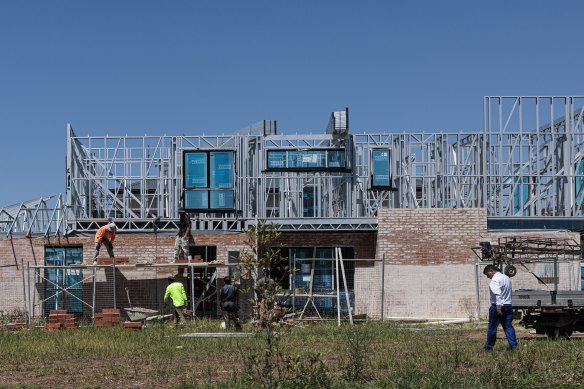- Exclusive
- Politics
- Federal
- Housing affordability
This was published 1 year ago
Property investors get bigger slice of federal housing budget
By Rachel Clun
Tax breaks for property investors make up the bulk of the federal government’s $27 billion annual outlay on housing, analysis shows, as Labor opens applications for public housing funding in its bid to address the current affordability crisis.
The federal government on Monday launched the first round of tenders for funding through its $10 billion Housing Australia Future Fund and is expecting applications from community housing providers, local councils and state and territory governments.

New analysis shows the bulk of federal government housing spending when tax concessions are included goes to property investors.Credit: Brook Mitchell
Housing Minister Julie Collins said this was just one part of the government’s housing agenda, and homes were starting construction in the first half of this year via the $2 billion social housing accelerator for states and territories.
“We are working at every opportunity to get as many homes on the ground as quickly as we can, understanding that this is a difficult task and we can’t turn this around immediately,” she said.
Analysis from think tank Per Capita found that when calculating key housing measures such as Commonwealth Rent Assistance and property tax concessions except for the capital gains exemption on the main home, the government’s annual spending on housing reached $27 billion in 2021-22.
Over the past 30 years, government housing policy has shifted emphasis from building social housing to topping up rents and incentivising investors, changing who benefits the most from funding and tax concessions.
Per Capita executive director Emma Dawson said in the late 1990s and early 2000s, the federal government leant towards tax concessions designed to stimulate economic output.
As a result of the strong take-up of incentives such as negative gearing, investor tax concessions have ballooned from $1.5 billion in 2000 to an estimated $18 billion, and the estimated share of government housing spending for the top 20 per cent of earners has soared from 9 per cent in 1993 to 43 per cent in 2023.
Around the same time, the government moved from directly funding social housing towards using Commonwealth Rent Assistance as its main form of support for low-income housing, and the share of housing spending for the lowest 20 per cent of income earners fell from 44 per cent to 23 per cent.
Commonwealth Rent Assistance was estimated at $4.8 billion in 2022-23.
The report doesn’t include recent measures from the 2023-24 mid-year economic and fiscal outcome, including $3 billion in performance-based funding for states and territories if home building targets are met, and $500 million to support local governments with infrastructure funding.
Dawson said the Albanese government’s suite of housing policies, including its Housing Australia Future Fund (which was not included in the spending estimate), a new national housing and homelessness plan, and work on a national rental accord, would “get the federal government back in the business of shaping the housing market, and that’s a good thing”.
When asked what the government was planning to help boost the number of workers in the building industry, which has a massive worker shortage, including whether it was looking at bringing more tradespeople from overseas, Collins said government ministers were “having conversations” about the skills needed.
“We’re working with the sector and working right across government to get the skills we need to build the homes as quickly as we can,” she said.
The federal government is also investing millions to make life easier for low-income households in other ways.
In partnership with the NSW government, Prime Minister Anthony Albanese announced a $206 million package for solar panel upgrades for low-income renters and apartment residents, and energy-saving upgrades for social housing properties.
Many social housing properties have low energy efficiency ratings, and upgrading a home from a one-star to a three-star rating could reduce energy consumption by 30 per cent, making energy bills cheaper.
Under the agreement, more than 24,000 social housing properties will be eligible for upgrades, including insulation, new heat pump hot water systems and reverse-cycle air conditioners, while more than 10,000 households will be eligible for rebates of up to 50 per cent on rooftop solar installation.
“Saving energy means saving money, which is why we’re continuing to deliver cost-of-living relief for families that need it most without adding to inflation,” Albanese said.
It follows a similar agreement with Victoria announced in August for a $108 million package to help apartment residents and social housing tenants improve their home’s energy efficiency or install solar panels.
Cut through the noise of federal politics with news, views and expert analysis. Subscribers can sign up to our weekly Inside Politics newsletter.